
Home - Search - Browse - Alphabetic Index: 0- 1- 2- 3- 4- 5- 6- 7- 8- 9
A- B- C- D- E- F- G- H- I- J- K- L- M- N- O- P- Q- R- S- T- U- V- W- X- Y- Z
CIA NIE March 1967

Soviet SL Numbers
Soviet launch vehicles, SL-1 to SL-11, as known to the CIA in February 1967. From National Intelligence Estimate 11-1-67.
Credit: LBJ Library
The CIA's National Intelligence Estimate 11-1-67 was handed to President Johnson in March 1967. It shows that the decision makers not only knew about the Russian lunar program, but were quite up to date with the latest Soviet schedule estimates. While their program information was solid, their knowledge of the Soviet launch vehicles and spacecraft under development was less so. This annotated version contrasts the CIA's knowledge of the program with what we now know to be the situation on the Russian side in February 1967. Special thanks to Peter Pesavento for providing the copy of this document, which he was able to have declassified by the LBJ Library back in 1993!
My comments are in italics after each paragraph of the original report.
(deletion)
NIE 11-1-67
2 March 1967
NATIONAL INTELLIGENCE ESTIMATE
NUMBER 11-1-67
The Soviet Space Program
Handle Via Indicated Controls
(deletion)
(deletion)
Submitted by
________________________________________________
DEPUTY DIRECTOR OF CENTRAL INTELLIGENCE
Concurred in by the
UNITED STATES INTELLIGENCE BOARD
As indicated overleaf
2 MARCH 1967
______________________________
EXECUTIVE SECRETARY, USIB
SANITIZED
E.O. 12356, Sec. 3.4
NIJ 92-320
By ___, NARA, Date 12-11-92
Pages 38
Copy No. 1
(snip) 23. The weight penalty imposed by the Soviet practice of using heavier, and simpler equipment in space payloads is not critical for near-earth operations. We believe that current Soviet technology could be extended with comparative ease to conduct further operations of this type. In more ambitious programs, such as a manned lunar landing, the saving of weight assumes greater importance. Advances in miniaturisation, packaging and other weight saving techniques as well as more powerful propellants would be needed to make more complicated missions practicable. Development of such technology is almost certainly underway at the present time.
24. High Energy Propellants A study of Soviet open source literature indicates an interest in high energy propellants such as liquid hydrogen and fluorine. (deletion) To date, no Soviet flight tests or space launches have been detected which use high energy propellants in any of the stages. However, we believe some phases of static testing are now being conducted and flight testing could begin in 1968-1969, possibly as part of the development of the system intended for Area J, and that about 1970 or shortly thereafter high energy upper stager could be man-rated and available for use with existing or more advanced space launch systems. Such upper stages will increase the capability and efficiency of the launch systems available to the Soviets and permit considerable flexibility in planning future space missions.
Comment: Glushko studied liquid fluorine/ammonia engines in 1960-1965 and qualified the RD-301 engine in 1965-1977, but due to safety considerations it was never used in a flight vehicle. Development of cryogenic liquid oxygen/liquid hydrogen engines was begun in 1960 by Lyulka and Isayev. Isayev's RD-56 began hot firing tests in June 1967. But despite numerous studies, beginning with the major N1 improvement study of November 1965, no authorisation to proceed with construction of a high performance upper stage for the N1 came until June 1970....
25. Launch Vehicles. In all their major space activities from 1957 through mid-1965, the Soviets used military boosters fitted with additional upper staging. The present Soviet inventory of boosters and the wide range of their payload capability have allowed them to pursue a diversified program. To undertake more complex space missions in the future, however, the Soviets are evidently now being forced to develop large boosters specifically for the space program; their military vehicles an not adequate for such missions. The chart on the following page depicts the various launch vehicle configurations the Soviets have used to date and shows the SL (space launcher) designations we have assigned to each
26. The booster designated SL-9, which is used in the Proton satellite program, is the first Soviet booster which we believe will be used solely as a space launcher. It is possible that this booster was originally to serve as a delivery system for the 100-MT nuclear weapon (of which Khrushchev boasted in the early 1960's as well as for space launchings, but we now believe that the former is very unlikely to be a present Soviet objective. The SL-9 system has an estimated first stage thrust of 2.5 to 3 million pounds and has demonstrated an earth orbit payload capability of about 27,000 pounds. There are reasons to believe however, that this system win soon be modified. (deletion). We therefore estimate that a third stage will soon be employed with the basic SL-9.
Comment: The CIA seemed very well informed about the Proton rocket, including matters that could not be guessed from overhead photography. They knew:
- The original purpose of the SL-9 / 8K82 Proton rocket (as a super-ICBM)
- The plan to add a third stage and modify it for use to launch manned space stations (the 8K82K, later designated SL-13 by the CIA, development decreed on 3 August 1964)
- The actual configuration of the vehicle (in the 1970's, Western aerospace analysts using open source information assumed the Proton first stage consisted of a core vehicle with six strap-on booster stages, analogous to the R-7 / Vostok vehicle. In fact it was a single stage built of modular components, like the American Saturn S-IB).
On the other hand, the CIA overestimated the thrust (2.5 million vs. 2.0 million actual) and payload (27,000 pounds vs. 18,400 pounds actual - but the Soviets put out intentional misinformation, including the mass of the final rocket stage in the spacecraft mass of the Proton). So it would seem they did not have, or did not want to reveal that they had, detailed engineering information on the booster....
27. The SL-9 with suitable upper staging would provide the Soviets with the capability to attempt a variety of advanced space missions, including manned space stations and manned circumlunar flights, as well as more ambitious unmanned planetary missions. The addition of a third stage employing conventional propellants, would allow a payload of some 50,000-60,000 pounds to be placed into near-earth orbit. With this in-orbit weight and a suitable injection stage, also using conventional propellants, a payload of approximately 15,000 pounds could be placed into a lunar transfer trajectory. We estimate that a payload of this weight would be adequate for the Soviets to attempt a manned circumlunar flight. The use of a high-energy third stage would allow a 70,000-80,000 pound payload to be orbited, (deletion). We believe that initial unmanned firings of the SL-9 with a conventional third stage will occur in the first half of 1967. Manned flights using this system could begin some six months to a year later, depending on the rapidity and success of the unmanned testing.
Comment: Again the capability is overestimated - actual low earth orbit payload of the 8K82K Proton is 44,000 pounds, and translunar payload was 12,000 pounds. On the other hand, they correctly identified the three original missions for the booster - space stations, manned circumlunar, heavy lunar and planetary probes. While Chelomei and Glushko studied advanced versions of the Proton using N2O4/Pentaborane in the lower stages, and liquid fluorine/ammonia in the upper stages, there is no evidence that Lox/LH2 upper stages were ever considered. First launch of the circumlunar version of the 8K82K (Cosmos 146) did indeed occur as predicted on 10 March 1967.
28. The construction of Complex J at Tyuratam makes it clear that the Soviets have under development another and much larger booster. Complex J is a very large launch facility which appears to be of the same magnitude as the US Apollo launch complex at Merritt Island. It has been under construction for the past 3 1/2 years and we estimate that it will be ready for initial launch operations in the first half of 1968 at the earliest. (Deletion) will accommodate vehicles with a first-stage thrust in the 8,000,000-16,000,000 pound range. It is possible that the system utilising the J-Booster will incorporate the SL-9 as its second and third stages. If such a combination were to be launched initially by about mid-1968, it could be ready for manned space missions by about mid-1969. If the entire vehicle is new, however, and uses conventional propellants in all its stages (we define conventional propellants as those which have been used thus far in the Soviet launch vehicles), it could probably not be man-rated before 1970 at the earliest. Either combination would permit payloads of 200,000-300,000 pounds to be put in near-earth orbit. The use of a high energy propellant in the out-of-earth orbit ejection stage for either of these combinations would allow them to be ready for manned flight about 1970 or shortly thereafter
Comment: In the same week this American report was issued, the Soviet government approved an integrated L1/L3 project plans indicating the first N1 launch in March 1968. A moon landing would not come until the third quarter of 1969 at the earliest. Therefore the CIA estimates fully reflected current Soviet plans. Construction of the N1 launch complex began in September 1963 and was detected by the CIA almost immediately (3 ˝ years prior to the report). Again detailed knowledge of Soviet program decrees is offset by mis-estimates in the technical areas. The use of Proton rocket stages from Chelomei's rival design bureau was never considered by Korolev (Chelomei had his own moon rocket design, the UR-700, that did use the Proton stages in the manner described by the CIA). The actual thrust of the N1 was 9.7 million pounds, and the payload into low earth orbit was to be 210,000 pounds, at the bottom of the range estimated.
29. Spacecraft. A new manned spacecraft which may be capable of rendezvous and docking has probably now reached the early, unmanned flight test phase. On 28 November 1966, and again on 7 February 1967, the Soviets used an SL-4 to launch Cosmos 133 and 140. The Cosmos 133 payload was deorbited on 30 November and Cosmos 140 on 9 February.
Comment: The new Soyuz spacecraft was indeed tested on the flights indicated by the CIA. Cosmonaut Komarov was killed on the first manned flight, that came only two months after the report was issued.
(snip)
53. The Soviets probably feel that during the next few years they must take steps to regain some of the prestige they lost to the highly successful US Gemini program Furthermore during 1967 two important anniversaries will be observed in the USSR: the 10th anniversary of the Sputnik I and the 50th anniversary of the October Revolution The Soviets probably have planned some form of space spectacular to celebrate one or both of these dates. Somewhat later they will be confronted with the necessity to at least partially blunt the international impact of the US Apollo program. For these reasons and considering the capability of the space hardware which they are now developing, we believe that the next five years will be a period in which the Soviets will attempt space ventures far more complicated and spectacular than heretofore undertaken.
Comment: There was indeed tremendous pressure to make some kind of manned launch before October 1967. The original plan was for a circumlunar flight to take place before this time; but hardware failures would make this impossible.
IV. OUTLOOK FOR THE NEAR TERM (1967-1972)
A. General
54. In considering developments in the Soviet space program over the next five years, we can estimate feasible extension of all current projects but it is difficult to determine which specific missions will be flown. We do not believe the Soviets have at hand all of the necessary technical and economic resources for undertaking all projects simultaneously. We therefore believe that some possible projects will not be attempted, others will be slowly paced, and substantial resources will be committed to only a few. The expansion of the reconnaissance project over the past two years shows that projects of demonstrable strategic value can and will be funded. While it is clear that useful missions can still be accomplished with existing hardware, it is equally clear that more spectacular and sophisticated missions will have to await the new hardware now under development
55. The Soviets, in their many official and unofficial statements about their space program, have given no indication of what the order of priority is to be. Indeed, much of what is said is conflicting or ambiguous. In arriving at likely dates for specific missions we have assumed a high but not complete level of success and a sharing of priorities among several categories of projects. In general, the likely date for any given mission would be a year or so later than that which we consider to be the earliest practicable date. We note that delay and failures have occurred and have sometimes plagued the Soviets for long periods. Such difficulties can recur at any time--especially upon the introduction of hardware based on new and more complex technology--and could delay achievement of a specific mission by a year or two.
Comment: The CIA accurately notes the grounds for the Soviet failure to beat the Americans around or on the moon - too many competing projects chasing limited resources, and delays and failures affecting optimistic schedules.
56. The Soviet manned lunar landing program and the large manned space station program are huge-scale undertakings, both of which require the use of the system intended for Area J. The dates we believe these ventures can be carried out are based on technical feasibility and do not take into account the order in which they may be attempted. We do not believe they could be undertaken concurrently. It must be understood therefore, that the one which is given priority may be carried out at the time indicated and that the other will he deferred for a year or so.
Comment: The large space station was the original design payload when the N1 was authorised in 1962. It reached at least mock-up stage but took a back seat to the lunar landing program from 1964-1969. After the Apollo 11 landing, if the N1 had ever been qualified, it likely would have become the primary project.
B. Manned Lunar Landing
57. (deletion) we estimated that the Soviet manned lunar landing program was probably not intended to be competitive with the Apollo program as then projected, i.e., aimed at the 1968-1969 time period. We believe this is probably still the case. There is the possibility, however, that depending upon the present Soviet view of the Apollo timetable, they may feel that there is some prospect of their getting to the moon first and they may press their program in hopes of being able to do so.
Comment: The CIA was more realistic than the Soviets as to schedule. The original program plan for the Soviet lunar landing was impossibly optimistic, expecting the landing to take place in 1967-1968, only three years after go-ahead. By the date of the CIA report, the Soviets had also concluded that they could not make a lunar landing until late 1969. But the Apollo 1 crew had been killed on a pad fire the month before. The string of successes in Apollo flight test that lay ahead and resulted in the July 1969 landing seemed very unlikely to the Soviets at this time. On such a crash program hope springs eternal. By March 1968 the Soviets knew they could not make a landing until 1970 and must have realistically believed that the race was lost. But they kept going; the possibility always existed that a catastrophe on an Apollo flight could result in a big delay like that after the Apollo fire, giving them a chance.
58. Several factors militate against their being able to compete with the Apollo timetable as originally planned. The status and pace of construction of Area J indicate that the launch system will probably not be ready for test until about mid-1968. When a launch vehicle is available. we would expect to see a series of tests for man-rating the system extending over at least a year before a lunar landing would be attempted. In the meantime, the Soviets will need to check out a new spacecraft, to test re-entry at lunar return velocities, and perhaps to develop a water recovery capability. Depending upon the technique selected, they may also need to test rendezvous and docking techniques and equipment.
Comment: In February 1967 first N1 launch was expected in March 1968. Nine months later this had slipped to the fall of 1968. First launch actually occurred in January 1969.
59. Some Soviet scientists have criticised the Apollo technique and stated that their lunar flight will go directly from earth to the moon's surface and return without any orbital rendezvous required. We estimate that any lunar landing mission which involves a single vehicle using conventional propellants would require a booster developing considerably greater thrust than Area J can accommodate. The Soviets have also discussed a technique involving the placing of components and fuel on the moon by two or more very large vehicles, then having cosmonauts assemble these components on the moon into a vehicle and fuel it for direct return to earth, This technique is risky since very accurate guidance is required to place the manned vehicle sufficiently close to the landing site of earlier flights and there is no provision for an abort of the manned flight.
Comment: It is interesting that the CIA evidently did not know the technical approach (lunar orbit rendezvous) selected by the Soviets for the landing or the spacecraft configuration. The lunar surface rendezvous technique mentioned here seems never to have been considered by the Russians.
60. Other techniques could involve rendezvous and docking of two or more very large vehicles in earth orbit for assembly and fuelling the lunar vehicle, before proceeding to the moon. The Soviets could also carry out two launches to the moon, one for landing on the moon and return to lunar orbit, and another for lunar orbit and return to earth. Either of these missions could be attempted within the capabilities we believe the Soviets will have when the Area J system is available.
Comment: The original September 1963 L3 concept involved assembly of a direct landing lunar spacecraft in earth orbit using three N1 launches and one Soyuz launch. By the time of the decision to put a Soviet man on the moon in August 1964, the American lunar orbit rendezvous technique was adopted, requiring one launch of an uprated N1.
61. If, however, the Soviets were to develop high energy propellants for use in upper stages of the Area J vehicle they could use any of a wide variety of mission profiles to put a man on the moon and return him to earth We have estimated earlier that man-rated upper stages using high energy propellants could be available about 1970 or shortly thereafter.
Comment: As noted before, authorisation to proceed with development o a high energy upper stage for the N1 did not take place until June 1970. However it was indeed designed for use in more capable lunar missions by the L3M lunar complex.
62. All things considered, we estimate that the earliest the Soviets could attempt a manned lunar landing would be mid-to-late 1969. We believe that the most likely date is sometime in the 1970-1971 time period
Comment: The CIA estimate is consistent with those of the Soviets in early 1967.
C. Manned Space Station
63. The Soviets are continuing to voice generalities about manned space stations. They refer to them by a host of terms such as cities in space, giant flying laboratories, scientific research institutes, refuelling stations, etc. Soviet statements frequently identify two broad space station functions: to pursue research objectives, and to serve as a launching or an assembly base for manned lunar and planetary missions. References to military applications of space stations have been conspicuously absent.
Comment:
64. Neither the interim nor ultimate configuration of a space station has been defined by the Soviets. Prerequisite techniques for a long-term space station would be manoeuvre, rendezvous, docking and extensive useful EVA. None of these techniques have been demonstrated in the Soviet manned space program to date, although the Soviets have been reporting a variety of laboratory simulations involving multiman crews for long periods of time.
65. Based on our expectation that the SL-9 with a conventional propellant upper stage will be used in the manned space program we believe that this system would be employed to orbit a manned space station or components thereof. A space station weighing approximately 50,000 pounds and capable of carrying a crew of three or more could probably be placed in earth orbit in the first half of 1968. This could be attempted in late 1967 as an 'anniversary spectacular' but only if the Soviets press this development. With a new spacecraft, rendezvous, docking and extravehicular operations could extend the operational lifetime of the station to several months and perhaps as long as a year. Alternatively. the Soviets could attempt a mission in late 1967 wherein the SL-9 would be used to orbit a large unmanned platform and the SL-4 could be used to put the new spacecraft into orbit to rendezvous and dock with the platform already in orbit. The crew could be augmented or exchanged by a man or two at a time by subsequent launchings.
Comment: The CIA seems to have had a very good understanding of the tangled web of competing Soviet military space station programs. Two parallel military space station projects - Almaz and Soyuz-R - ran simultaneously from 1964 to 1966. Then the Soyuz-R was cancelled. However in the combined reformulated project the Soyuz 7K-TK ferry craft was to have been used as a shuttle vehicle to the Almaz, just as described by the CIA. By 1967 the Soviet Almaz schedule was for the Almaz/Soyuz 7K-TK system to be tested in 1968 and enter service in 1969, consistent with the CIA assessment. After many twists and turns, the actual first launch of the Soyuz-derived Salyut 1 did not occur until 1971.
66. We believe that the Soviets will probably also develop and establish a very large manned space station (We define a space station as a multimanned, nonrecoverable orbiting vehicle intended for prolonged use-a minimum of a month. The crew could be recovered by deorbiting a portion of the vehicle; alternatively crew recovery or resupply could be carried out by a ferry vehicle). This development will probably be one separate from their manned lunar landing program and probably not be conducted concurrently with that program at Area J. It appears likely that the booster being developed for use with the Tyuratam Area J launch facilities will be capable of placing on the order of 200,000-300,000 pounds in near-earth orbit. A weight budget of this magnitude is sufficient for a variety of activities about which the Soviets have spoken. A space station of this size would permit a permanent or semi-permanent space laboratory to be placed in orbit by mid-1969 at the earliest. We believe the most likely date is sometime in the 1970-1971 time period. Rotation of personnel and resupply of the station would be accomplished by spacecraft having a rendezvous and docking capability.
Comment: The large N1-launched OS space station was indeed pursued from 1962 until 1969. It was abandoned after the initial N1 launch failures and priority given to the smaller Salyut space station program. Although much related to the OS remains obscure, the CIA was accurate on other schedule assessments, so this provides a guide to their schedule and intentions in the absence of declassified Soviet material.
D. Manned Circumlunar
67. We think it probable that the Soviets will attempt a manned circumlunar flight as a step in a program having more ambition objectives as its subsequent goals, such as a manned lunar landing or manned flights to explore other planets. The Soviets have sometimes described such a flight as one preliminary activity leading up to the manned landing. They may also consider that an early manned circumlunar flight would pay important dividends in terms of prestige and could be a means to offset some of the propaganda value of the US Apollo program.
Comment: The circumlunar program was indeed authorised in August 1964. The comment about planetary manned exploration is interesting - the Soyuz capsule would have been the re-entry vehicle for the various Mars expedition schemes of the mid-1960's. The MEK concept of 1970 even had a Proton-launched circumlunar version of Soyuz being used to transport the crew to the Mars spacecraft after it had cleared the radiation belts on its slow acceleration spiral from low earth orbit.
68. The Soviets could attempt a manned circumlunar flight by using existing hardware. In order to do so they would need to add a Venik upper stage to the SL-9 system, man-rate this combination with an SL-8 final stage, and modify the Voskhod spacecraft to give it a midcourse correction capability. This combination could put a payload of about 15,000 pounds on a circumlunar trajectory, which would permit the Soviets to send a crew of two on a circumlunar flight. Alternatively, the Soviets may choose to utilise a new conventional-propellant upper stage designed to be flown with the SL-9 system and the new spacecraft with a midcourse guidance capability inherent in its design.
Comment: This description of the circumlunar launch vehicle indicates an amalgam of intelligence from the two competing Soviet circumlunar designs. The first alternative described seems to be the CIA's own invention. The Voskhod spacecraft, which was incapable of lifting re-entry, was never considered as a circumlunar capsule. A tenuous connection between Soviet circumlunar craft and the SL-3 Kosmos launch vehicle third stage may exist. From 1964 to 1965 the Soviet manned lunar spacecraft was the Chelomei LK-1. This used the 3-stage Proton to reach low earth orbit, then an RB translunar injection stage. This stage's engine is somewhat mysterious. It was unusually from the Izotov bureau, had been used in the last stage of the UR-100 ICBM, and was to have been used in the ascent stage of the LK-700 lunar lander. It had a thrust very close to that of the earlier Isayev 11D49 engine used in the second stage of the SL-8 Kosmos launcher. In October 1965 Korolev seized the circumlunar program from Chelomei, retaining the Proton launch vehicle, but changing the trans-lunar injection stage and spacecraft. A ‘Venik' upper stage would be taken to be the Block L stage of the Molniya launch vehicle - from which indeed the Block D stage used on the Proton for circumlunar flights was developed. The last sentence clearly refers to the Korolev circumlunar solution...
69. We believe that an attempt toward a manned circumlunar flight would be preceded by at least one unmanned mission utilising the same mission profile and hardware. We believe that test flights over a period of about sir months would be required to man-rate the system and to test the equipment and recovery techniques for water landing which may be required for a manned circumlunar flight.
Comment: These were indeed the Soviet's expectations. In February 1967 they planned to conduct one Soyuz 7K-L1 mission a month, leading to a manned circumlunar flight as early as June 1967. There did indeed seem to be enough margin to beat the Americans around the moon before the 50th anniversary of the October revolution. Although the first test launch in March was successful, this was followed by the Soyuz 1 disaster and a string of failures in testing the L1 design. By June the project was reorganised and monthly launches leading to a manned circumlunar light in November were planned. Five days later NASA decided to send Apollo 8 around the moon in December. Further problems with the Proton booster and Soyuz spacecraft led to the Americans being first around the moon.
70. Optimum "window" conditions for a Soviet manned circumlunar flight occur during the first 5 to 6 months of the year when the moon is at a northerly declination For this reason, we believe that the earliest the Soviets would attempt a manned circumlunar flight would be during the first half of 1968. It is conceivable that they would attempt such an operation as an "anniversary spectacular" in late 1967, but because of the grave risks involved we believe that it is unlikely that they will do so.
Comment: This CIA analysis of trajectories is not echoed in Soviet plans. It is not clear if the CIA is referring to the possibility of ‘free return' trajectories or additional propulsion requirements. In any case the Soviets planned manned circumlunar flights for anywhere from June 1967 to November 1968.
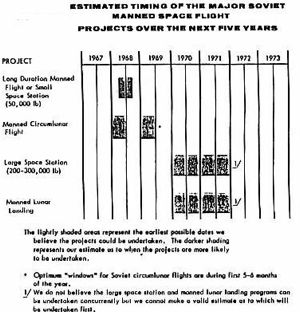 | Soviet Lunar Plans CIA Assessment of Soviet lunar and space station plans in February 1967. Credit: LBJ Library |
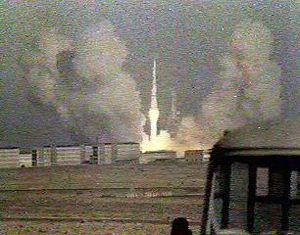 | N1 7L lift-off N1 7L rises over the apartment blocks of the workers that built it Credit: RKK Energia |
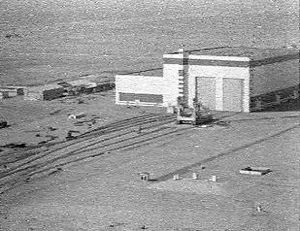 | N1 MIK Assembly Hall CIA's National Intelligence Estimate of March 1967 Credit: RKK Energia |
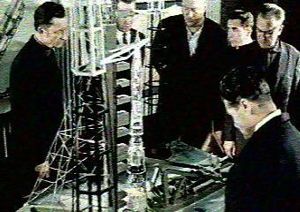 | Model of N1 pad Credit: RKK Energia |
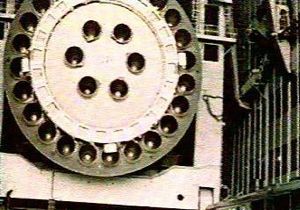 | N1 Rollout N1 Rollout - base of booster Credit: RKK Energia |
Back to top of page
Home - Search - Browse - Alphabetic Index: 0- 1- 2- 3- 4- 5- 6- 7- 8- 9
A- B- C- D- E- F- G- H- I- J- K- L- M- N- O- P- Q- R- S- T- U- V- W- X- Y- Z
© 1997-2019 Mark Wade - Contact
© / Conditions for Use